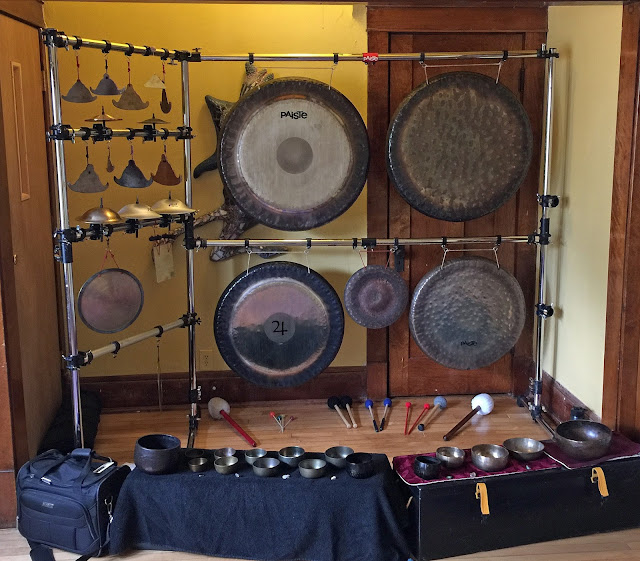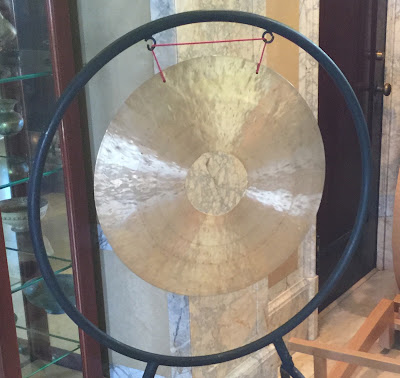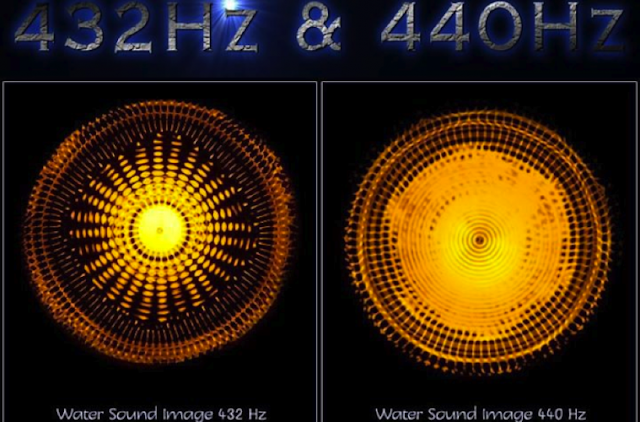Further adventures in Choosing & Using Multiple Gongs
Today, more thoughts based on the continuing Facebook conversation on choosing a gong. If you are part of the FB conversation, be patient, as I will repeat some of the thoughts I have posted there.
As a note of disclosure, I must tell you that I have played Paiste products for well over 40 years and that I have been an endorsing artist for the past 15 years.
I love Paiste gongs and will most likely love them until the day I die. While I find their sound amazing and very useful for the work I do, currently Paiste only makes 1 type of gong with 1 type of sound (OK, there are 2 minor exceptions in their greatly reduced Sound Creation line). The Paiste Symphonic & Planet Gongs are essentially the same thing, with the same sound characteristics. The Planets Gongs are really just a more focused sounding Symphonic. They are centered around a specific pitch, while the Symphonic is not. But if you play 2 same sized Symphonic and Planet Gongs side by side, they will sound a lot alike. In fact, all Symphonic & Planet Gongs sound alike, as there is one overall type of sound dictated by both the shape of the gong and the metal used (nickel-silver). And all the tunings are in a rather narrow frequency range. This holds true for the new Meinl Planet & Symphonic Gongs also.
With this in mind, I never understood people who play like, 15 Paiste gongs in their set up, because they all sound similar/the same! Why have 4-32" gongs that are only tuned a fraction apart??? Why not have 32/28/24/20" gongs that give you a wider note spread (although still stuck in that narrow frequency range)? The same thing holds true for Meinl's current nickel-silver gongs.
If you really want to expand your game, you need to add different types of gongs, made from different metals, and with different shapes. Large Chinese Chau, Wind, or Heng Gongs, made of bell bronze, will move your range down, even to sub-octaves. Smaller ones, up to 6" in diameter, will move your frequency range up. And the very different styles of gongs from a variety of regions in Asia, will not only give you a different/wider frequency range, they will give you a broader pallet of sound textures/timbres. From there, you can also add some of the amazing and innovative gongs from the individual gongsmiths who have sprung up in the last 20 years. People like Hubback, Nolan, Shelledy, Blau, etc. These people are making some seriously spectacular sounds!
http://www.stevehubback.com
https://www.mattnolancustomcymbals.com
http://rmshelledy.com
https://blaugong.wixsite.com/gongblau
Getting your hands dirty
http://www.stevehubback.com
https://www.mattnolancustomcymbals.com
http://rmshelledy.com
https://blaugong.wixsite.com/gongblau
Getting your hands dirty
It's too easy (read as lazy) to say, “I want a Chiron gong because it's the ‘wounded healer’ gong and it will help my clients work through past trauma.” You then order the gong, get it, play it, and go, “Meh,” because the actual sound/vibrations do nothing for you. In the same way, it’s easy to just take a recommendation from myself, or someone else, and buy a gong without ever hearing it first, only to discover it does nothing for you.
All gongs will work well together if you take the time to work with them and understand them.
That said, I’ve bought a lot of gongs ‘sound unheard’ off ebay/the internet. But I’ve also played a lot of gongs in my life, so I can have a reasonable idea of what something will likely sound like. But more importantly, my criteria for choosing and using gongs is probably much different than yours, as I always approach things as a percussionist, not as a healer/therapist/woo woo instigator.
I’ve gotten gongs I really didn’t like at first, but kept working with them, learning how they respond, building a relationship with them. And some of those have now become my favorites out of the 80+ gongs I own. Some gongs are challenging, demanding, frustrating, and, ultimately rewarding if you stick it out and work with them over time (sometimes years!). Most people aren’t willing to invest the hours, and energy, to develop a personal relationship with the gong, to where it will finally yield it's sound up to you. Most people don’t dig past the surface of playing gongs, because they don’t have the true commitment to go 120% in.
In conclusion, don't get too hung up on all the cosmic theories and nonsense out there. Just buy something you like the sound of, play the heck out of it, learn it, know it, understand it—but don’t expect to get to the deeper truths without putting in some hard work…
~ MB
Chop Wood / Carry Water / Play Gongs™





Once again you have hit the gong with the mallet dead center. I have been suspicious about buying planet gongs and probably will not. I hot an Atlantis 32 from GU and if you spend time with it its awesome. Has a throb that nothing else of its size has. And my Shelledy 24 symphonic is totally different from my 24 paiste accent ( if you take the time to get to know them better). Your sound😊 advice and my ituition have paid off. Next I am going huge wind gong (i have 22) and bigger symphonic (i have 30). I think I can visit the planets (and take other folks) without the planet gongs. I am always looking for something different.
ReplyDeleteThank you as always for your SOUND advice and for getting me started on this road that has literally...changed my life.
Thanks for your comment. As for the Planet Gongs, I've played all of them, and they really are fantastic sounding gongs. The ones I use I picked out for the sound they produce and nothing else. ~ MB
Delete